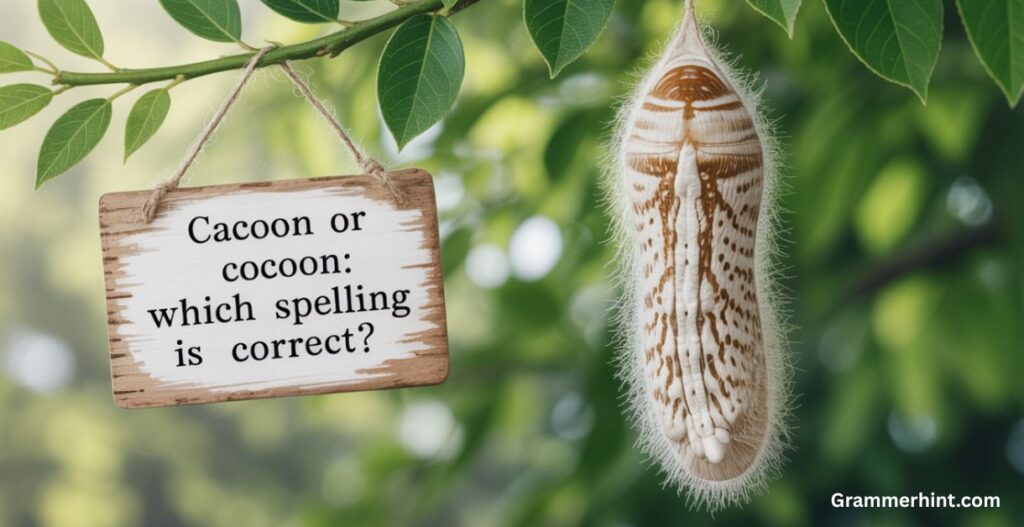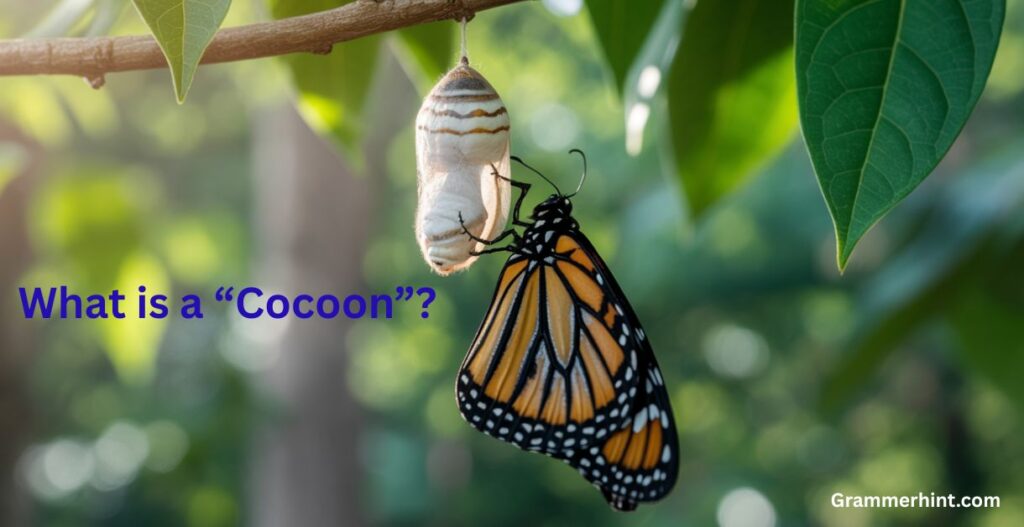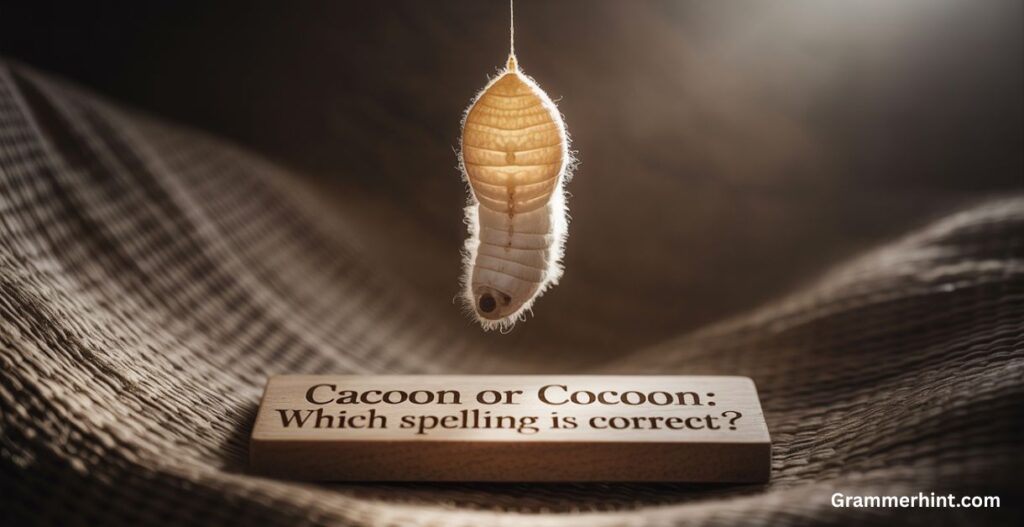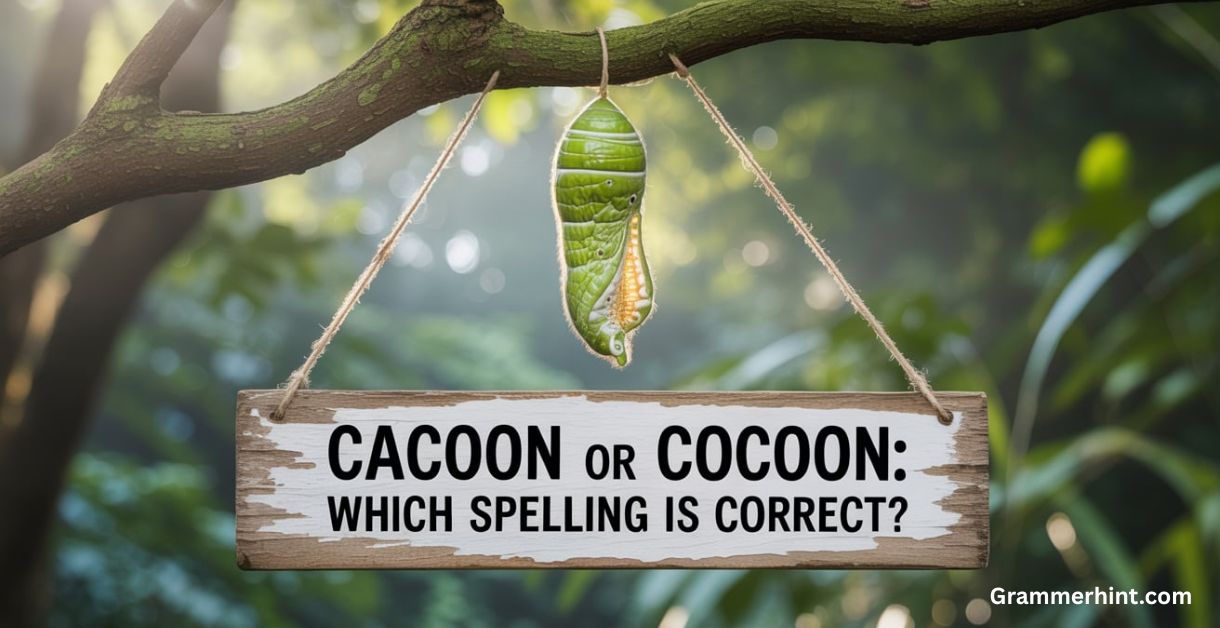Have you ever stumbled upon the words cacoon or cocoon and paused for a second, unsure which one is actually right? If yes, you’re not alone. Many people ask, “how do you spell cocoon?” and the answer often surprises them.
This article digs deep into the correct spelling vs. common misspelling, explores English orthography and phonetics, and dives into the worlds of insect metamorphosis, traditional plants, and even furniture design to explain it all.
Why is There Confusion?

The confusion between cacoon vs cocoon arises primarily due to spelling confusion in English. Words that sound similar often referred to as homophones or near-homophones lead to a high number of common spelling mistakes in English.
English, unlike phonetic languages, doesn’t always follow a predictable pronunciation-to-spelling rule. This inconsistency results in many cases where people rely on how a word sounds rather than how it’s spelled and that’s how cacoon emerged as a common misspelling of cocoon.
What is a “Cacoon”?
Cacoon is not the correct spelling of the word used to describe the silky protective covering spun by insects. However, the word “cacoon” has evolved into a commercial and botanical term, giving it a place in modern usage — though not in the way most expect.
Cacoon in Botany
In botany, Cacoon refers to the snuffbox bean, scientifically known as Fevillea cordifolia. It’s a woody vine found primarily in the West Indies and parts of Africa, known for its decorative beans and historical value in traditional medicine.
Fun Fact: In the Caribbean, “cacoon” is used in traditional medicine and is considered a part of cultural and regional plant usage.
Cacoon in Design
In commercial design, Cacoon is also a brand name for a style of hanging chairs. A Cacoon chair offers a retreat-like experience, much like a cocoon, hence the brand’s metaphorical link. You’ll often see references like:
- Cacoon bean
- Cacoon furniture
- Cacoon hammock
So while cacoon is a misspelling of cocoon in many English writing contexts, it has carved out niche uses in botanical terminology and product branding.
What is a “Cocoon”?

The word cocoon is the correct spelling for the silky protective casing insects create during metamorphosis. If you’ve ever seen a caterpillar spin a shell around itself before becoming a butterfly or moth, that shell is called a cocoon.
Cocoon in Entomology
- Cocoon is formed during the pupal stage of an insect’s life.
- Common among silkworms, moths, and some beetles.
- It’s part of the fascinating process of insect transformation.
The cocoon acts as a metamorphosis shell, sheltering the insect as it changes form — a perfect symbolism of protection and transformation.
Cocoon in Furniture
In modern design, the word cocoon has been used metaphorically:
- Cocoon chair: A soft, enclosed, cozy furniture piece that offers a retreat space.
- Cocoon furniture: Designs that envelope the user in comfort, mimicking the insect’s safe space.
- Cocoon-inspired furniture: Common in wellness spaces or reading nooks.
In both nature and design, cocoons serve as metaphors for comfort, protection, and emotional isolation.
“Cacoon” vs “Cocoon”: The Differences
Spelling:
- Cocoon = ✅ Correct
- Cacoon = ❌ Often incorrect (unless referring to specific plants or brands)
Meaning:
- Cocoon: Protective shell by insects or a comforting, enclosed space
- Cacoon: Botanical term (Fevillea cordifolia) or branded furniture product
Usage:
- In science and general English: Always use cocoon
- In niche contexts: “Cacoon bean” (botany) or “Cacoon chair” (brand name)
Examples of “Cacoon” and “Cocoon” in Context
“Cacoon” in Context
Email Example – Botanical Use:
Subject: Inquiry About Cacoon Bean Benefits
Hi Dr. Evelyn,
I came across an article about Fevillea cordifolia, also called the cacoon bean, and its role in traditional medicine. Could you share more about its uses in West Indies herbal practices?
Thanks, Kara Odom
Interior Design Inquiry:
Subject: Custom Order for Cacoon Chair
Hi Luke,
I’m interested in purchasing the Cacoon chair you featured in last month’s catalog. It looks like the perfect protective space for our wellness room.
Best, Joanna R.
Cocoon in Context
Email Example – Scientific Use:
Subject: Research on Silkworm Cocoon Structure
Hi Professor Lang,
As part of my thesis on insect metamorphosis, I’m studying the composition of the silkworm cocoon. Could you recommend any journals that cover the pupal stage?
Regards, Carlos Pena
Marketing Copy:
“Sink into the luxurious comfort of our Cocoon Chair — a cocoon-inspired furniture masterpiece that wraps you in tranquility.”
Origins of “Cacoon” and “Cocoon”

Origins of “Cacoon”
The term cacoon in the botanical sense likely stems from Caribbean languages and Yoruba origin. It’s connected with Fevillea cordifolia, a plant used in traditional West Indian medicine.
Its spelling may have been influenced by phonetic similarity to “cocoon,” but it’s distinct in application and etymology.
Origins of “Cocoon”
The word cocoon has deeper historical roots:
- From French: coque meaning “shell”
- Derived from Latin: coccum (meaning berry or scarlet dye)
- Related to Greek: kokkos (grain or seed)
This shows a clear lexical evolution and etymology, forming a robust link between ancient languages and today’s spelling.
Conclusion
So, how to spell cocoon correctly? The answer is simple:
- For anything related to insects, furniture, or metaphors of comfort and transformation, the correct spelling of cocoon is cocoon.
- The word cacoon is a misspelling in English, unless you’re referring to the snuffbox bean or branded furniture like a Cacoon chair.
In the battle of cocoon or cacoon, cocoon wins in standard English. But cacoon has its own niche in botanical terminology and product names.
Always double-check if you’re using the word in the context of insect protection, metaphorical cocoon, or a tropical plant. If you’re still unsure, remember this guide and you’ll never second-guess the spelling again.









